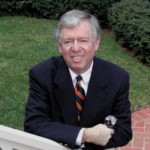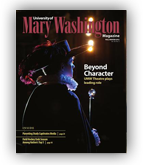 The Chappell Great Lives Lecture Series, which begins its 10th season in January, has evolved into the University’s highest-profile community outreach program, bringing hundreds of people to campus weekly during the spring semester for lectures by some of today’s most prominent biographers.
The Chappell Great Lives Lecture Series, which begins its 10th season in January, has evolved into the University’s highest-profile community outreach program, bringing hundreds of people to campus weekly during the spring semester for lectures by some of today’s most prominent biographers.
Great Lives was modestly inaugurated in 2004 – created more out of necessity than by grand design. The impetus was the need for another course to serve an increasing number of history students without putting an additional burden on departmental faculty. The solution was to create a multidisciplinary, team-taught course that could draw upon the expertise of not only the history department but of other departments as well.
The resulting course, “Great Lives: Biographical Approaches to History,” included lectures by faculty from 10 disciplines across the University. Students were immediately attracted to it, as enrollment approached 100.
Considering the success of the history department’s free public lectures in the past and the widespread popularity of biography as a historical genre, it seemed a good idea to open the lectures to the community.
The initial public lecture drew a near-capacity crowd to the 200-seat Monroe lecture hall; the following week’s presentation attracted an audience so large that many had to be turned away. Ever-increasing turnout necessitated moving the talks to successively larger venues, ending in Dodd Auditorium with its 1,200 seats.
What accounts for the success of Great Lives? Fundamentally there is the inherent appeal of biography. People tend to be interested in the lives of others, thereby making biography a useful and accessible approach to the study of history.
More specifically, there is the program’s diversity, not only in race and gender, but also in chronology and fields of accomplishment. Its subjects include persons both admirable and, occasionally, abominable. (The operating principle is that “great” means not necessarily good but influential in some way.) Thus the series has examined not only monumental figures, but also some of lesser fame, such as Mildred and Richard Loving, whose victory in the 1967 Supreme Court case Loving v. Virginia outlawed the state ban on interracial marriage. Indeed, some of the more popular topics have included nonhuman subjects, such as the great Virginia thoroughbred Secretariat and even a few fictional characters – Frankenstein, James Bond, and Harry Potter.
Among the criteria for choosing topics is their relevance to contemporary events, such as last year’s lecture on the founder of the Girl Scouts, which coincided with that organization’s 100th anniversary; ongoing lectures on figures relating to the Civil War sesquicentennial; and next year’s lecture on Queen Elizabeth II to commemorate the 60th anniversary of her reign.
Also, an effort is made to feature authors who have recently published biographies of significant subjects and whose works have been critically acclaimed. Among the latter have been numerous nominees for prestigious literary awards, including two recipients of the Pulitzer Prize in biography: in 2010, T.J. Stiles for Cornelius Vanderbilt; and in 2011, Ron Chernow for George Washington.
In addition to introducing some of history’s most fascinating figures, Great Lives has also demonstrated a potential for inspiring students. Rosemary Velasquez ’06,a student in Great Lives’ very first semester, wrote some years later about her experience. “This was by far the most influential class I ever took,” she recalled. “At 21, walking alone on campus, I constantly asked myself after each lecture: How will I lead a great life? What can I do to leave my own mark?” Velasquez eventually decided that her future would be working with Girl Scouts in her native Texas, where she is now an executive.
Thus far, the series has investigated the lives of more than 150 figures – and there’s no shortage of subjects. A recent audience solicitation of prospective topics produced nearly 400 nominees.
Given the public’s obvious appetite for studying both the famous and the infamous in history, it appears that the future of Great Lives is, indeed, great.
